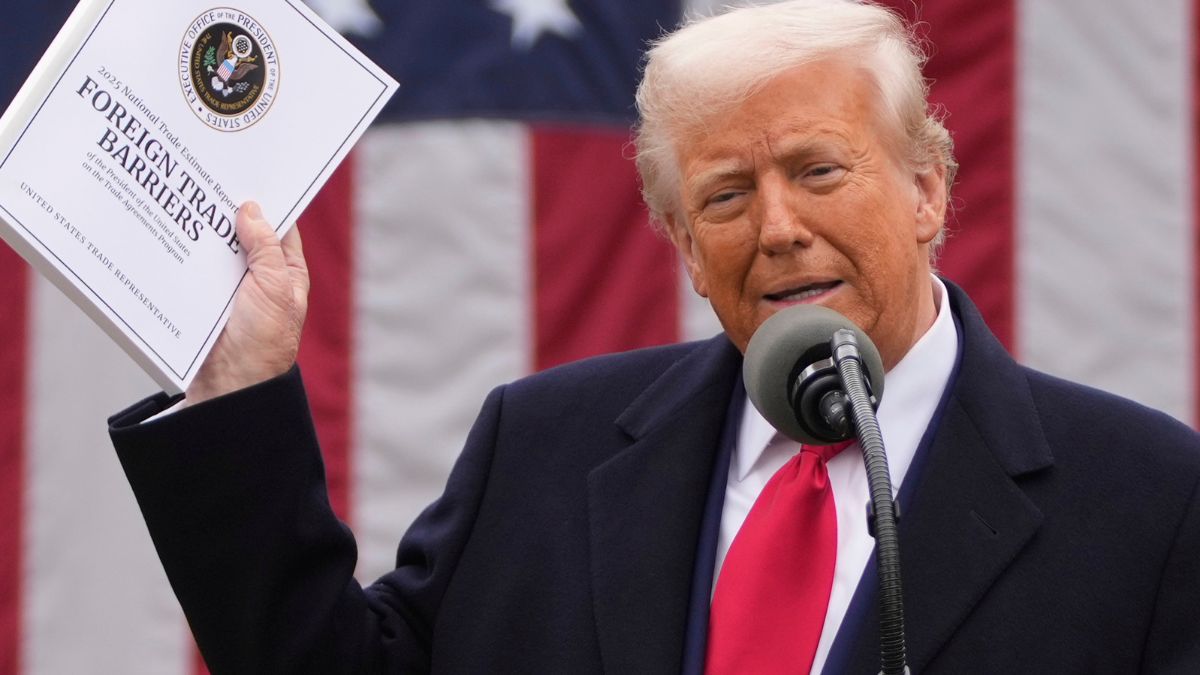US President Donald Trump on Wednesday shocked many by announcing a 90-day pause on reciprocal tariffs.
Trump, however, ramped up the game of high-stakes poker with China – announcing he was raising tariffs on Beijing to 125 per cent from 104 per cent.
The development comes days after Trump insisted that his ‘reciprocal tariffs’ are working.
The US president insisted that America was raking in $2 billion a day as a result of the tariffs.
But what did Trump say? Is that true?
Let’s take a closer look:
What did Trump say? Is that true?
“America is going to be very rich again, very soon,” Trump claimed on Tuesday. “We’re making a fortune with tariffs – $2 billion a day.”
“Money is pouring in at a level we have never seen before,” Trump added.
Trump offered no explanation of how he arrived at that figure.
As per The Guardian, Trump’s baseline tariffs of 10 per cent took effect on April 5.
The other tariffs came into effect from midnight on April 9.
However, the newspaper pointed out that tariff exempt goods from China are already on the way to the US by sea.
It will likely be weeks before the exempted goods arrive.
But what about the additional revenue that the tariffs are likely to generate?
The newspaper quoted data from the US treasury department as showing that “customs and certain excise taxes” have brought in around $200 million per day in April.
That figure was at $7.25 billion for the entire month of February.
Since 1 October, 2024, the US has taken in around $75 billion in customs duties and excise taxes.
That’s nowhere near Trump’s proclaimed figure of $2 billion.
So, what then?
According to BBC, it is possible that Trump has pulled out the number based on a the past.
For example, the US imported $9 billion worth of goods every day in 2024.
Analysts have said that the average rate of Trump’s tariffs (as of 2 April) is 22 per cent.
Adding 22 per cent to these figures would result in the US get you to the $2 billion per day mark.
But there are a number of problems with this calculation.
First, it assumes that US imports would remain at this level.
This is no sure thing amid a trade war with China .
Already, a number of companies including Amazon are cancelling import orders from Beijing due to the tariffs.
Trump could also be relying on White House’s senior counselor for trade and manufacturing Peter Navarro.
Navarro, a noted tariff and China hawk, claimed the tariffs would result in $700 billion per year.
This equates to around $2 billion per day.
But even if that were true, one can’t simply take Navarro’s word.
After all, this is a man who has admitted to fabricating an expert ‘Ron Vara’ who he has frequently quoted in his books.
Experts say even if Trump’s tariffs go into effect, they could raise far less than the $2 billion per day he promised.
The Guardian quoted the Tax Foundation thinktank as saying that the tariffs, if made permanent, could generate $2.9 trillion over a decade.
That works out to $300 billion per year.
The Wall Street Journal quoted Capital Economics as predicting the tariffs would bring in a maximum of $835 billion.
The firm revised the figure down to $700 billion (or 2.3% of GDP) due to the fact that higher tariffs result in fewer imports.
But “assuming such high tariffs lead to a marked decline in imports, the increase in revenues will probably end up closer to $700 billion,” they wrote in a note to clients.
That would bs equivalent to 2.3 per cent of the US’ gross domestic product.
The final problem is that other countries don’t pay tariffs.
Instead, tariffs are paid by American companies importing goods, who ultimately pass on the additional burden to US consumers – a fact Trump simply doesn’t understand or is unwilling to.
Trump, in effect, with his has passed the single largest tax increase in history on US consumers.
This doesn’t even take into account the other negative impact of tariffs – higher inflation, retaliatory action by other countries and dented business and consumer confidence.
China vows not to back down
After Trump announced the tariffs on China would be raised to 125 per cent, Beijing has vowed not to back down.
“If the US insists on further escalating its economic and trade restrictions, China has the firm will and abundant means to take necessary countermeasures and fight to the end,” China’s Ministry of Commerce said.
In Washington, White House press secretary Karoline Leavitt said: “When you punch at the United States of America, President Trump is going to punch back further.”
Though the US and China may want to find a way back to the negotiating table, “this won’t be an easy path to navigate with both countries doubling down and bilateral engagement at a virtual standstill,’’ said former US trade official Wendy Cutler, a vice president at the Asia Society Policy Institute.
China does not appear interested in bargaining, as some other countries have started doing.
With inputs from agenices


)

)
)
)
)
)
)
)
)



